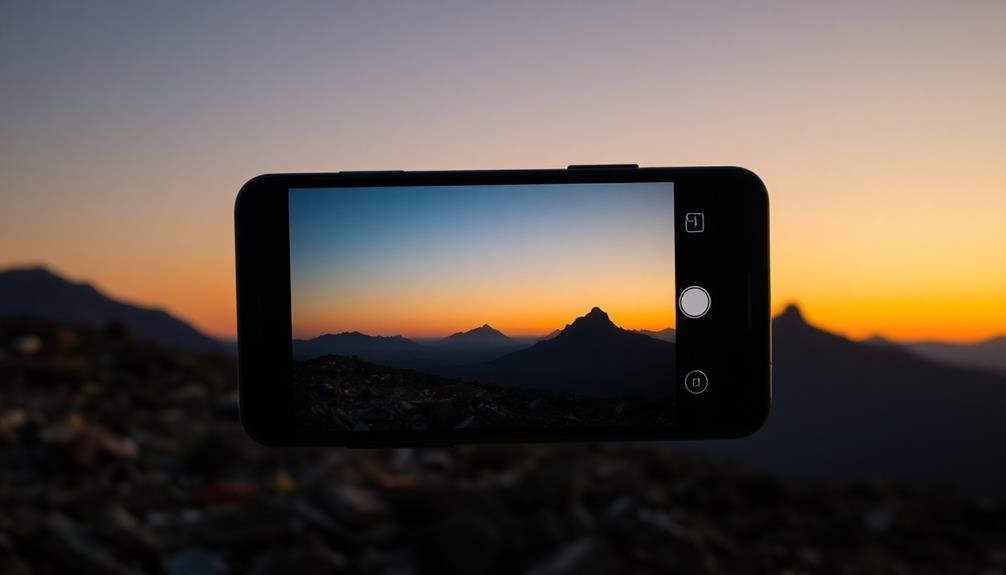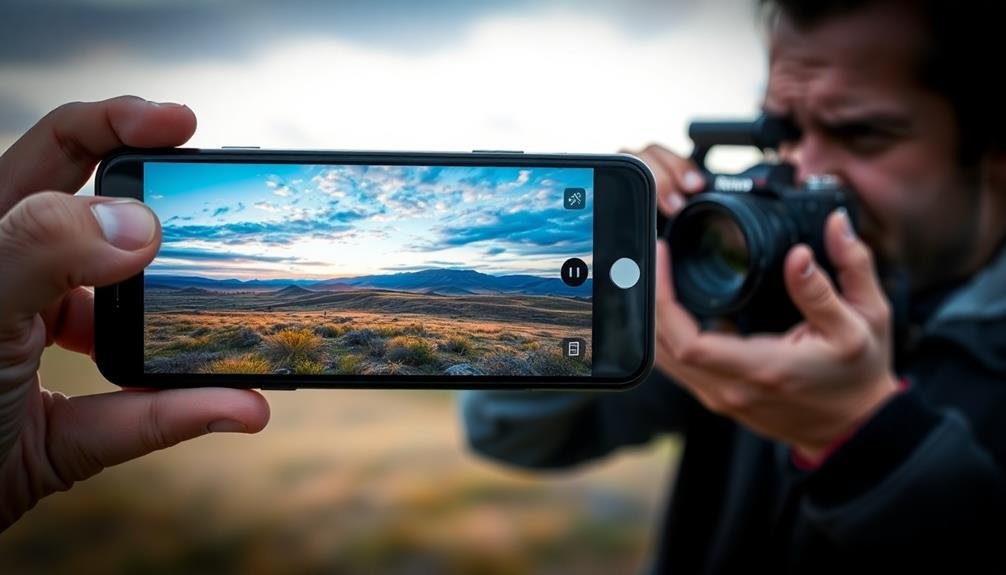When capturing landscapes with your mobile device, avoid these three common blunders. First, don't neglect composition rules like the rule of thirds and leading lines, which can enhance balance and depth. Second, resist overusing filters and effects that can make your images appear artificial and oversaturated. Instead, opt for subtle adjustments to exposure and contrast. Finally, pay attention to natural light conditions; the golden hours after sunrise and before sunset offer soft, warm light that enhances depth and dimension. By mastering these aspects, you'll elevate your mobile landscape photography. Discover more tips to transform your outdoor shots into enchanting visual stories.
Neglecting Composition Rules

Why do so many mobile photographers overlook basic composition rules? It's often due to the ease and speed of snapping photos with smartphones. However, neglecting these fundamental principles can greatly impact the quality of your landscape shots.
The rule of thirds is an essential composition technique you shouldn't ignore. Imagine your frame divided into a 3×3 grid, and place key elements along these lines or at their intersections. This creates a more balanced and visually appealing image than centering your subject.
Leading lines are another powerful tool. Use natural elements like roads, rivers, or fences to guide the viewer's eye through your photo. These lines add depth and draw attention to your focal point.
Don't forget about framing. Use foreground elements like tree branches or rock formations to create a natural frame around your main subject. This adds context and depth to your landscape.
Pay attention to the horizon line. Keep it straight and avoid placing it in the center of your frame. Instead, position it along the upper or lower third of your image for a more dynamic composition.
Overusing Filters and Effects

While mastering composition is important, another common pitfall in mobile landscape photography is the excessive use of filters and effects.
It's easy to get carried away with the myriad of options available in mobile editing apps, but overusing these tools can detract from the natural beauty of your landscape shots.
When you apply too many filters or effects, you risk making your images look artificial and oversaturated. This can lead to a loss of detail and texture in important elements like clouds, water, or foliage.
Instead of enhancing your photo, heavy-handed editing often creates an unrealistic representation of the scene.
To avoid this blunder, use filters and effects sparingly. Start by making subtle adjustments to exposure, contrast, and color balance.
If you do choose to apply a filter, opt for one that complements the mood and atmosphere of your landscape. Remember, the goal is to enhance the natural beauty of the scene, not to completely transform it.
Consider using selective editing techniques to target specific areas of your image rather than applying effects globally.
This approach allows you to maintain the integrity of the original scene while still making impactful improvements to your landscape photos.
Ignoring Natural Light Conditions

In the domain of mobile landscape photography, natural light is your most powerful ally. Yet, many mobile photographers overlook its importance, leading to underwhelming results. Understanding and harnessing natural light can dramatically improve your landscape shots.
Pay attention to the golden hours—shortly after sunrise and before sunset—when the light is soft and warm. This lighting can add depth and dimension to your landscapes. Midday light, often harsh and unflattering, can create strong shadows and washed-out colors. If you must shoot during these hours, look for ways to use the light creatively or seek out shaded areas.
Don't ignore overcast days; they can provide even, diffused light that's perfect for capturing details and colors. When shooting in low light, use your phone's night mode or manually adjust exposure to avoid grainy images.
Be mindful of the direction of light. Side-lighting can enhance textures and create interesting shadows, while backlighting can produce dramatic silhouettes. Experiment with different angles to see how light changes your composition.
Frequently Asked Questions
How Can I Stabilize My Phone for Sharper Landscape Photos?
To stabilize your phone for sharper landscape photos, you'll want to use a tripod or prop it against a stable surface. You can also try using your phone's timer or voice commands to avoid camera shake when pressing the shutter button.
What's the Best Time of Day to Capture Stunning Landscape Shots?
The best times for stunning landscapes are during the "golden hours" – just after sunrise or before sunset. You'll get soft, warm light that adds depth and drama to your shots. Don't forget to experiment with different times too!
Should I Use HDR Mode for Landscape Photography on My Phone?
You can use HDR mode for landscapes, but don't overdo it. It's great for balancing high-contrast scenes, but it can make images look unnatural. Experiment with HDR and compare results to find your preferred style.
How Can I Protect My Phone's Camera Lens During Outdoor Shoots?
You can protect your phone's camera lens by using a lens cover or case. Keep it clean with a microfiber cloth, avoid touching it directly, and use a protective filter. Don't expose it to extreme temperatures or moisture.
Are There Any Apps Specifically Designed for Mobile Landscape Photography?
Yes, there are several apps designed for mobile landscape photography. You'll find options like Snapseed, VSCO, and Lightroom Mobile. They offer advanced editing tools, filters, and features specifically tailored to enhance your landscape shots on the go.
In Summary
You've learned about three common mobile landscape photo mistakes to avoid. By paying attention to composition rules, using filters sparingly, and working with natural light, you'll greatly improve your shots. Remember, practice makes perfect. Keep experimenting with your phone's camera and don't be afraid to try new techniques. Soon, you'll be capturing stunning landscapes that'll make your social media followers stop scrolling. Happy shooting!





Leave a Reply